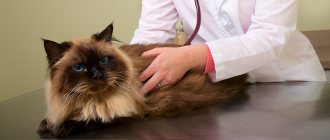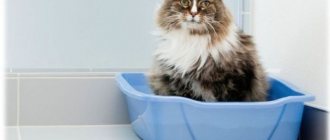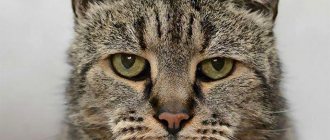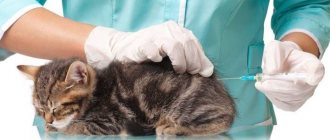Feline idiopathic cystitis (FCI)
Feline idiopathic cystitis (FIC) is the most common cause of lower urinary tract symptoms in cats.
This form of disease is very similar to what is called “interstitial cystitis” in humans. Just like in humans, controlling cystitis is quite difficult. Idiopathic cystitis occurs in approximately 60% of cats with bladder disease. In this case, the presence of all clinical signs of cystitis is noted, but the urine is sterile and, as a rule, salt crystals are also not detected.
Causes
It has not yet been proven what exactly causes interstitial cystitis in cats. The leading theory cites stress as the main cause. Scientifically speaking, emotional discomfort activates the sympathetic nervous system, causing a constant release of adrenaline.
- Sick animals exhibit decreased levels of cortisol and sometimes a decrease in the adrenal glands that produce this hormone.
- In humans, low cortisol causes irritability and depression, and this is probably true for cats as well.
In addition to disorders of the nervous and endocrine systems, scientists have discovered changes in the wall of the bladder. Normally, the epithelium produces a protective layer of glycosaminoglycans. This substance prevents pathogenic microbes from gaining a foothold on the wall and, moreover, protects the nerve endings of the bladder from the irritating effects of urine.
In cats with Pandora syndrome, the mucopolysaccharide lining contains extensive defects, leading to inflammation and severe pain. It is not yet clear whether this is a cause or a consequence of the disease.
Risk factors:
- obesity;
- keeping several cats together;
- lack of walking and low physical activity;
- sudden changes in life (moving to a new home).
The infection has nothing to do with the occurrence of idiopathic cystitis.
Urology and nephrology
Services
Feline idiopathic cystitis (FCI)
Feline idiopathic cystitis (FIC) is the most common cause of lower urinary tract symptoms in cats.
This form of disease is very similar to what is called “interstitial cystitis” in humans. Just like in humans, controlling cystitis is quite difficult. Idiopathic cystitis occurs in approximately 60% of cats with bladder disease. In this case, the presence of all clinical signs of cystitis is noted, but the urine is sterile and, as a rule, salt crystals are also not detected.
What causes of cystitis can be identified?
Idiopathic cystitis is a disease with a still unclear cause. However, a number of studies in cats with ICC revealed abnormalities of the bladder, dysfunction of the parasympathetic system and corticoadrenal system:
Bladder lining defects —the cells lining the bladder lining are made of glycosaminoglycans, which help protect the bladder wall. Since urine consists of a liquid with a high concentration of many substances that, without such protection, have an irritating effect. In cats with cystitis, defects in the mucous layer are found or it is not dense enough. This can lead to damage to the cells of the underlying layer, causing ulceration, irritation and inflammation.
Neurogenic inflammation – nerve endings in the bladder wall can be stimulated either by local irritation of the bladder lining or by signals from the brain (for example, in response to stress). Stimulation of these nerves causes the release of chemical compounds called neurotransmitters that can exacerbate local inflammation and cause pain.
Stress - it has been clearly proven that stress plays an important role in the development of cystitis in cats. Many episodes of cystitis exacerbation are triggered by stressful situations for cats.
Neuroendogenous changes - there are quite a lot of facts indicating that it is not only stress itself that provokes cystitis. Many cats exhibit “wrong” reactions to stressful situations. Cats with cystitis have abnormal cortisol production.
Here are the risk factors for the disease:
- Persian;
- Animal age 2-6 years;
- Overweight, low physical activity;
- Low water consumption;
- Low activity level;
- Using a tray;
- Unexpressed hunter behavior;
- Coexistence in a conflictual relationship with another cat living in the same house;
- A more timid and nervous cat compared to other cats living in the same house;
- The habit of hiding when strangers appear in the house;
- Moving.
What clinical signs of cystitis can be identified?
The signs of cystitis are similar to those of other lower urinary tract diseases. The most commonly observed are the following:
- Dysuria - difficult or painful urination;
- Pollakiuria - frequent urination;
- Hematuria - the presence of blood in the urine;
- Periuria - urination outside the litter tray;
- Overgumming (excessive licking of fur) in the perineal area;
In some cats, cystitis may cause blockage of the urethra as a result of severe inflammation and spasms of the muscles surrounding the urethra.
With cystitis, many cats experience symptoms not constantly, but periodically. Signs can develop quickly, gradually fading after 3-7 days. Relapses often occur after 1.5 years, and sometimes more often.
How is cystitis diagnosed?
Diagnosis of ICC is carried out by excluding other diseases (mainly urolithiasis and urinary tract infections) that cause symptoms of lower urinary tract disease.
This means that the cat needs to:
Only after excluding other diseases can we talk about feline idiopathic cystitis.
In cats with cystitis, a urine test may show the presence of blood and inflamed cells when there is no reason (such as bladder stones or infection) to explain the changes. Usually, microscopic crystals, most often struvite (magnesium ammonium phosphates) or calcium oxalate, can also be found in urine samples. However, such crystals do not cause cystitis (inflammation of the bladder) and can usually be found in completely healthy cats, since cats have very concentrated urine (in which crystals form easily).
How is ICC treated?
First of all, you need to focus on proper nutrition and improving the cat's living conditions, as they are important in the treatment of cystitis.
Encouraging more frequent urination and, accordingly, the production of less concentrated urine should alleviate the condition of a cat with cystitis. This is achieved in part by changing the cat's normal diet. A good effect, along with other measures to increase water consumption, is achieved by switching from dry food to wet food.
In addition to moisture-containing foods, veterinary therapeutic diets (only those recommended by a physician) have been formulated for cats with lower urinary tract disease. Such diets include polyunsaturated fatty acid supplements, which have the potential to reduce inflammation.
Additional measures to increase your cat's water intake:
Your cat should always have fresh water. Some cats prefer running water (there are special fountains for such cats) - this also stimulates water consumption;
Signs of the disease
Manifestations of idiopathic cystitis are not specific and are common to many urological disorders:
- frequent urge to urinate;
- severe pain when trying to urinate;
- tiny amounts of urine in the wrong places;
- blood in the urine (brown discharge);
- urinary retention;
- decreased or lack of appetite;
- deterioration in the appearance of the coat;
- excessive grooming in the genital area, lower abdomen;
- digestive system disorders (vomiting, diarrhea);
- nervousness, fearfulness.
Similar symptoms occur in urolithiasis and urinary tract infections. Since it is not possible to prove idiopathic cystitis through research, such a diagnosis is made by exclusion. If all possible diseases with similar symptoms are crossed out, including oncology of the urinary system, then we speak of idiopathic cystitis.
The disease is characterized by a sudden onset and acute course: from 1 to 7 days. The symptoms may go away without treatment. Symptoms usually recur after some time.
Symptoms of idiopathic cystitis in cats.
Many cats with ICC have recurrent, or waxing and waning symptoms. The most commonly observed symptom is increased frequency of urination (pollakiuria). The inflammatory process causes affected cats to repeatedly run in and out of their litter box while producing only small amounts of urine.
If frequent attempts to urinate do not produce urine, it is important to consult your veterinarian immediately. Some cats with inflammatory bladder disease develop stones and other debris that can form an obstruction in the urethra (the narrow tube leading from the bladder to the outside world). Other cats seem to show only functional obstruction, with pain and spasm, but no stones or debris. A urethral obstruction results in the inability to urinate and is a truly dangerous situation that requires emergency medical attention. The longer, narrower urethral canal in male cats makes them more susceptible to obstruction than male cats.
In addition to increased urinary frequency, symptoms associated with FCI often include:
- Restlessness;
- Straining to urinate;
- Blood in the urine;
- Excessive licking of the penis or vulva;
- Urinating in inappropriate places (outside the cat's litter box);
- Screams and other sounds during urination.
Diagnostics
A urine test reveals hematuria (a huge number of red blood cells). To exclude infection, a bacteriological examination of urine is carried out - culture on nutrient media. For such an analysis, a sample of the material must be obtained sterilely, by cystocentesis - a puncture of the bladder through the abdominal wall. Although this procedure is performed without anesthesia, it has not yet become routine practice in Russian veterinary clinics.
If cystitis recurs, culture is necessary. It is also recommended for all animals over 10 years old and cats with immune disorders:
- diabetes;
- VIC;
- treatment with steroid hormones.
Ultrasound and radiography can detect stones and sand in the urinary tract, assess the thickness and tone, and fullness of the bladder.
In exceptional cases, contrast radiography or urethrocystoscopy may be required, most often if neoplasia is suspected.
Diagnostic measures
To determine an accurate diagnosis, laboratory diagnostics are needed.
Stress cystitis in cats is determined by a veterinarian by palpation of the abdomen and kidney area. To accurately establish a diagnosis, diagnostic methods are prescribed, such as:
- urine test;
- radiography;
- Ultrasound of the kidneys;
- urethrocystoscopy if necessary.
Treatment
Although in 8 cases out of 10 the symptoms of cystitis will go away on their own, the doctor’s task is to alleviate the symptoms of the acute period for the animal. Apply:
- antispasmodics (Drotaverine, Papaverine);
- painkillers (Butorphanol, Meloxicam).
For blockage of the urethra and urinary disorders, alpha-blockers (Terazosin, Prazosin) are used, which relax the internal sphincter of the bladder and the urethral canal.
Treatment aimed at the long term involves changing the conditions of detention. Eliminating the cause of stress is necessary to avoid relapse of the disease. Idiopathic cystitis is not a problem that can be solved by taking medications.
Products based on cat pheromones may be useful. Feliway in the form of a diffuser or spray stabilizes the psychological state of a cat without side effects or contraindications. An analogue of the substance secreted by the cat’s facial glands will give the pet a signal: “there is nothing to worry about.”
Supplements with alpha-casozepine (derived from casein, a milk protein) and L-tryptophan (an amino acid from which serotonin, the happiness hormone, are formed) reduce the risk of developing depression and reduce stress. There are industrial complete diets that include both harmless substances:
- Royal Canin Calm 36;
- Hill's c/d Feline Urinary Stress.
This diet is suitable for long-term feeding of a cat with idiopathic cystitis, if there are no associated problems:
- urolithiasis disease;
- obesity;
- renal failure.
Features of application
Serenia injections are given subcutaneously to cats. For every 10 kg of weight you need 1 ml of medicine. To accurately measure the required amount of the drug, it is advisable to use an insulin syringe. In addition, the presence of a thin needle can significantly simplify the administration of medicinal liquid. You can give injections at home. When administering an antiemetic, the cat must be securely restrained as the injection is painful.
Injections are given once a day. Treatment continues until vomiting disappears, but not more than 5 days. In practice, 1-2 injections are enough to stop vomiting from bothering the animal, but in severe cases, longer treatment may be necessary.
Tablets are used only to prevent motion sickness. You need to give them to your pet a few hours before the trip for the medicine to start working. Serenia can be hidden in food, since its digestibility and effect do not depend on food.
In most cases, one dose is enough for your pet to survive the trip without any problems. In rare cases, the medication is repeated every other day. The dosage is calculated: 8 mg of active substance per 1 kg of weight, that is, a 100 mg tablet is designed for an animal weighing 2-2.5 kg.
An antiemetic can be combined with antibiotics, painkillers and other drugs, but only a veterinarian can prescribe complex treatment.
Prevention
Prevention consists of providing the cat with conditions that satisfy its basic instinctual needs:
- Shelter.
The cat should have a shelter where no one will disturb it. This could be a house or a box, a closet shelf, a mezzanine - if the animal likes to sleep on high places.
- Relaxed meal.
The bowl of food should not be in the aisle. If there are several animals in the house, it is necessary to exclude competition for food.
- Toilet.
The tray is placed in a secluded, quiet place where no one will disturb the cat. It is recommended to give your pet the opportunity to dig for litter. The tray is kept clean by removing excrement and regularly disinfecting the plastic.
- Activity.
The older a cat gets, the more important it is to stimulate its hunting instincts. Gradually, the animal in the apartment gets tired of the monotony and becomes inactive. The owner should play with the pet every day. Interactive feeding bowls and other puzzles from which the cat must “get” food can be useful.
In addition to psychological comfort, it is important to keep the animal in good physical shape.
In addition to preventing obesity, they strive to ensure urine dilution. Reducing urine density has a positive effect on the treatment of cystitis and is extremely important for preventing relapses. Less concentrated urine does not irritate the damaged bladder wall as much.
You can increase the amount of water your cat drinks by switching from dry food to canned food. For drinking, they offer water with flavoring additives and an attractive aroma: shrimp broth, tuna juice. Many cats prefer running water, in which case a drinking fountain should be installed.
To dilute urine, special diets are used:
- Royal Canin Urinary S/O Feline High Delution;
- Purina Veterinary Diets UR St/Ox – Urinary Feline;
- Eukanuba Urinary Struvite Feline;
- Hill's PD Feline C/D or S/D.
Situations that cause discomfort to the cat should be avoided as much as possible. If stress is inevitable (the birth of a child, a change of owners, moving to a new home), the cat can be prepared for it in advance:
- 10-30 days before the event, the animal is switched to RC Calm food and continues to be given it for another 2-3 months.
- During a stressful situation, use Feliway, and for particularly anxious individuals, the use of antidepressants is justified.
Tricyclic antidepressants are relatively safe, although they cause side effects - drowsiness, physical inactivity. Amitriptyline is widely used in cats orally or intramuscularly.
Establishing diagnosis
A diagnosis such as idiopathic cystitis is very difficult to make. Most often, veterinarians use the method of excluding other pathologies. To examine the animal, the following procedures are prescribed:
- taking a general blood and urine test;
- X-ray examination of the bladder;
- ultrasound examination;
- performing cystoscopy.
A cat urine test will show specks of blood and inflammatory cells. In addition, the composition will contain crystals. Only after a comprehensive examination of the animal has been carried out and diseases of the lower parts of the urinary system have been excluded, can a diagnosis of idiopathic cystitis be made.
Testing is an important step in making a diagnosis.










